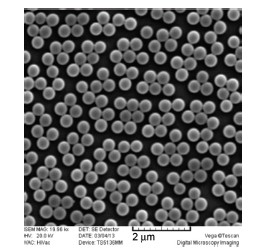| [1] Elsabahy, M.; Wooley, K. L. Chem. Soc. Rev. 2012, 41, 2545.[2] McDonald, C. J.; Bouck, K. J.; Chaupt, A. B. Macromolecules 2000, 33, 1593.[3] Poma, A.; Turner, A. P. F.; Piletsky, S. A. Trends Biotechnol. 2010, 28, 629. [4] Li, W.-H.; Stöver, H. D. H.; Hamielec, A. E. J. Polym. Sci., Part A: Polym. Chem. 1994, 32, 2029.[5] Ma, G.-H.; Fukutomi, T.; Nazaki, S. J. Appl. Polym. Sci. 1997, 63, 1243.[6] Arshady, R. Polym. Eng. Sci. 1990, 30, 905.[7] Meng, J.-Y.; Gao, B.-J.; Chen, Z.-P.; Yao, L. Acta Chim. Sinica 2012, 70, 2273. (门吉英, 高保娇, 陈志萍, 幺兰, 化学学报, 2012, 70, 2273.)[8] Kawaguchi, H. Prog. Polym. Sci. 2000, 25, 1171.[9] Hao, Z.-X.; Cheng, Y.-Y.; Wang, L.-L.; Wang, X.-G.; Zhu, Z.-R.; Gan, L.-H.; Xu, Z.-J.; Chen, L.-W. Acta Chim. Sinica 2012, 70, 331. (郝志显, 程艺艺, 王乐乐, 王晓岗, 朱志荣, 甘礼华, 徐子颉, 陈龙武, 化学学报, 2012, 70, 331.)[10] Oh, J. K.; Drumright, R.; Siegwart, D. J.; Matyjaszewski, K. Prog. Polym. Sci. 2008, 33, 448.[11] Li, K.; Stöver, H. D. H. J. Polym. Sci., Part A: Polym. Chem. 1993, 31, 3257.[12] Wu, J.-Z.; Huang, G.; Hu, Z.-B. Macromolecules 2003, 36, 440.[13] Zhang, Q.-S.; Tang, Y.-C.; Zha, L.-S.; Ma, J.-H.; Liang, B.-R. Eur. Polym. J. 2008, 44, 1358.[14] Halperin, A.; Kroeger, M. Macromolecules 2011, 44, 6986. [15] Qian, J.; Wu, F.-P. J. Mater. Chem. B 2013, 1, 3464.[16] Bai, F.; Yang, X.-L.; Li, R.; Huang, B.; Huang, W.-Q. Polymer 2007, 47, 5775.[17] Dai, Z.; Yang, X.-L.; Huang, W.-Q. Polym. Int. 2007, 56, 224.[18] Bilalis, P.; Boukos, N.; Kordas, G. C. Mater. Lett. 2012, 67, 180.[19] Ji, M.; Liu, B.; Yang, X.-L.; Wang, J.-Y. Polymer 2009, 50, 5970.[20] Pan, Y.-J.; Li, D.; Jin, S.; Wei, C.; Wu, K.-Y.; Guo, J.; Wang, C.-C. Polym. Chem. 2013, 4, 3545. [21] Ma, M.-F.; Wu, K.-Y.; Tang, J.; Li, D.; Wei, C.; Guo, J.; Wang, S.-L.; Wang, C.-C. J. Mater. Chem. 2012, 22, 15206. [22] Ma, W.-F.; Zhang, Y.; Li, L.-L.; Zhang, Y.-T.; Yu, M.; Guo, J.; Lu, H.-J.; Wang, C.-C. Adv. Funct. Mater. 2013, 23, 107.[23] Pan, Y.-J.; Chen, Y.-Y.; Wang, D.-R.; Wei, C.; Guo, J.; Lu, D.-R.; Chu, C.-C.; Wang, C.-C. Biomaterials 2012, 33, 6570.[24] Bai, F.; Yang, X. L.; Huang, W.-Q. Macromolecules 2004, 37, 9746. |
